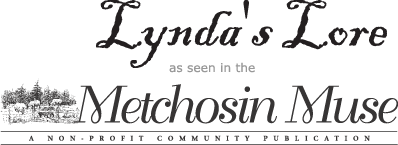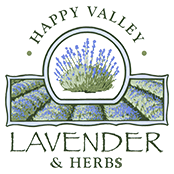|

January 2008
Herb Watch
Thoughtful choices for adding new herbs to your collection
Welcome to the New Year and your new gardening plans and schemes….Just this weekend I got together with a fellow gardening zealot and we were going through our fall home garden collected seeds and sorting our bought seed half packages from our passionate spring seeding session of 2007…All those hopes and dreams of having the right plant in the right place at the right time AGAIN! After 45+ years of playing with seeds, shuffling plants here and there: and yes, yet again moving it way over there…I realize you can be too successful with some plants.
What about all those “super successful” Herbs in particular that I would handle differently starting a virgin patch of ground? You may be familiar with some of these exuberant Herbs yourself or with any luck: you are only beginning a herbal collection now and can gain insight from my thought provoking experience.
It is easy to designate dark dramatic personalities to even the most romantic herb garden plant selection, labelling some herb species lightly as “Weeds” or add a few cursing words in front of their titles and call them… %#*THUGS! (I don’t have enough symbols on my keyboard to do justice to the language I have heard from gardeners describing their misfortune with some of their herb planting choices!) And perhaps that is the key word…choices...choices of the planter and not the plant itself. Perhaps it is only gardening mismanagement by your “Head Gardener”. (Blame the staff!) I remember Murray Cook distinctly advising me against planting Greater Celandine anywhere in my yard regardless of its historical medicinal virtues of removing children’s’ warts as successfully as “Compound W”. At the time I was deeply in my medicinal herb collecting phase, deafly as it turned out, as 24 years later I still remove its not so innocent babies from edges of gardens whose medicinal design left long ago from where I planted the first little sucker. (And yes Greater Celandine does help remove children’s warts BUT!). It was one of my first introductions of a “too successful” Herb; regretful, although useful.
January and February are traditional seed selecting times…many a rainy night you will find me pouring over all those alluring catalogues. Please take heed of the truthful language so lightly sprinkled in the descriptors! It will not necessarily be as blatant as; “invasive”, “rampant”…“roots deeply to Tibet or speeds across to the Florida coast”. The truth will be hidden in language niceties as: “seeds freely”, “matures quickly” …has a “strong root system”. The Chilterns seed catalogue always delights me with its language; I have been known to laugh out loud just reading the descriptors like a novel! (Chilterns are also more truthful at times.) Take notes of these three families of “super successful” Herbs, ideally before introducing to your garden:
1) The Seed Invaders:
Who would think one innocent looking 4” plant could populate all corners of your yard plus the neighbours on both sides!
- Chives
- Fennel, especially Bronze one
- Feverfew
- Greater Celandine
- Lemon Balm
- Milk Thistle
- Motherwort
- Mullein
- Nettles
- Pennyroyal
- Sweet Cicely
- St John’s wort
2) The Root Group:
Although unseen by the naked eye this one networks under the soil resembles the invisible internet network of the sky.
- Artemisia Silver King
- Achillea the Pearl
- Agrimony
- Coltsfoot
- Comfrey
- Greater Celandine, again
- Hops
- Horseradish
- Loosestrife
- Periwinkle
- Soapwort
- Sweet Cicely, again
- Tansy
3) The Space Gobblers:
… “Those other herbs are just so slow to take advantage of all that useable land.” Some of these don’t run but one plant can simply muscle an amazing amount of personal space!
- Angelica
- French Sorrel
- Honeysuckle
- Labrador Violet
- Lovage
- Mints
- Mugwort
- Oregano
- Self Heal
- Sweet Woodruff
- Vervain
- Wild Marjoram
- Wood Betony
…As you can see, we have quite a range here from Cooking Herbs and Medicinal Herbs, to Craft Herbs and ones that just looked nice in a photo landscaping with Herbs…Add in others simply because Shakespeare romantically linked them in his poetry…a new group of historical Herb seduction!
Do I still have all of the above Herbs in my yard, whether I still desire them or not? YES! So please before you panic and rush outside to rip every Herb OUT, one control method: check out today’s topic.
Herb Management 101
Some of these listed herbs are being perfectly normal.
Revisit the Herbs you already have. What are your favourites regardless of their growing style? How can you both be happy in your garden? It may be as simple as your “Head Gardener” not thinking through their needs versus their characteristics. Try placing them in a not-so-perfect place to curb their vigorous appetite in your garden space. Or conversely, use the very characteristics that drive you wild to your advantage by letting them “free” in hard to grow spots of your yard…This does not mean somewhere where their allotted space is a tidy six inch square. This rearrangement does need a little homework. And do take the time to read up before you introduce a new one, you will save yourself hours of weeding later!
Basically, Seed Invaders can not spread by germination if they do not mature their seeds. Cut the flowering heads off before they ripen.
Roots can not move freely if they are restricted. This includes sidewalks as barriers, dry zones under the house eves or rocky ledges. Note: this group also has amazing regeneration abilities from leaving the tiniest root bit behind that can mature into a whole new unwanted adult plant. Ask my Dad about taking a rototiller to his comfrey plant/patch! (Stay tuned: March’s topic will be…Herb Containers 102)
Gobblers can be managed by not allowing your patch to get so large. Learn to be more ruthless donating to your compost pile. Your friends will not remember you fondly for being the benefactor of their #%* THUGS in your angst to simple find a new home for your extras. Please throw them away. The bonus here is that you keep your Herbal specimens vibrant, healthy and productive. I do find Herb gardens in general need a good work over every 5 years or so to keep them NOT looking like a whole patch of weeds! Spring is a great time to chop off a chunk before they fully awake to keep the manicured yet romantic look. Please do not just plant and walk away unless the “jungle look” is your plan…mostly all the above Herbs will simply take over. Where will you find space for that new Cinnamon Basil seed you are ordering?
…I know it is January, so I am not asking to be out there in the jungle yet. Simply keep a good reference book by those seed catalogues and use them like a duet. Spring will find you singing with the birds instead of %#*cursing the plant spirits for your unwanted super success with your un-beloved Herbs!
Happy Hibernation ~ Lavender Lynda
Originally published in the January 2008 edition of the Metchosin Muse
Printable Version 
|

